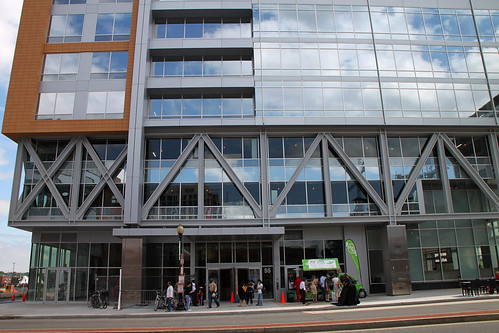 I finally went to Artomatic today and saw floors 3 and 4. I also walked around the work-in-progress Waterfront area around Nationals Park. I'm not a really a baseball fan, so it's not a neighborhood I would go to, but art puts me in an ambitious and introspective mood, so now I want to write about what I saw.
I finally went to Artomatic today and saw floors 3 and 4. I also walked around the work-in-progress Waterfront area around Nationals Park. I'm not a really a baseball fan, so it's not a neighborhood I would go to, but art puts me in an ambitious and introspective mood, so now I want to write about what I saw.The first thing I walked away thinking was, unfortunately, how much I disliked the area's new architecture. And this is especially troubling for me, because I normally love contemporary architecture.

55M, home of Artomatic 2009. Note the exposed diagonal supports and the
asymmetrical but still right-angle dominated façade.
I'm not a trained architect, tho I did present failed a bid for a Fulbright scholarship on postmodern monumentalization in Germany. So I feel especially well-qualified to write about this.
Much of what's built these days is given the moniker of postmodernism. This is not the place for a philological deconstruction of the term or it's nauseating overpresence in today's commentary, so I will only say that I think the term is somewhere between troublesome and abhorrent.

Bank Center, Houston. The shape suggests urban architecture in
the Netherlands, recalling Dutch financial dominance.
Postermodern architecture often references preexisting concepts
rather than copying them outright as is done in revivalism.
Postmodernism is our generation's rejection of 20th Century functionalism and it tries, sometimes desperately, to relocate the importance of ornamentation. It draws from the Brutalism that almost took over DC in the seventies, the high-tech exposure which still seems to frighten Americans, and the old standby international style that defines many American skylines.

Every underground Metro station features Brutalist style in the ceiling pattern.
Brutalism does not fail on it's theory – leaving artifacts of the form's construction is not
inherently bad – but in practice it seems to dominate entire structures, and it certainly
dominated Washington's last urban renewal after the riots. (The fearsomely ugly FBI
building is another prominent example).
Although that pedigree is clear at the Waterfront, there is no revivalism and no homage on display in this development. (That's not a judgment, just a statement.) The materials are cutting edge and the form reflects this. The capabilities of the material allow for hints of the underlying structure and process of the building to show thru, suggesting a sort of neo-Brutalism or neo-high-tech. However, unlike Brutalism and high-tech, these styles are not the focus of the building, but only possibilities. The brackets that hold the windows are capped with stainless steel. The elevator is visible, but its machinery is tucked away.


Postmodern additions add contemporary functionality to history structures.
Left: New DC Court of Appeals at Judiciary Square. The postmodern atrium obviously alters the form from its original. It defaces the historic building but does not offend it.
Right: Nevada State Museum, Carson City. I haven't seen this in person yet, tho I'm excited to get the chance. It's one of the coolest museums anywhere (not being ironic!) and I want to feel how it works.
So all we have left to describe what we see is postmodernism. And it feels so... unsatisfying. Why do I like this style at Judiciary Square, and why am I excited about it at the Nevada State Museum, but it feels so sickly and sterile at the Waterfront? Part of my frustration, I think, is that the style has no inherent life – a fact made clear when you walk thru the empty lobby of 55M. Flat light seeps thru the glass or plastic walls of the room, ensuring no corner is hidden in shadow. Marble, wood and brass, materials prevalent in the decadent neo-classical government buildings, is non-existent here. In theory, this should create a sense of egalitarianism in the space, where the people are foremost, but I suspect that in practice this forces the people to architecturalize themselves. The seams of their pants, the cut of their décolletage, the tattoos on their skin must provide the context.

Sadly, this is not the Rotunda of the Capitol, where Americans of every type gather to observe and interpret their collective self. In its attempt to move beyond the nostalgia of repeatniks and conservatives, it has created a lifeless fashion runway that only waits for models and designers to fight over their individuality. It creates competition, not community.
The art inside the building, however, is great and I'm excited to head back tonight and tomorrow!




No comments:
Post a Comment